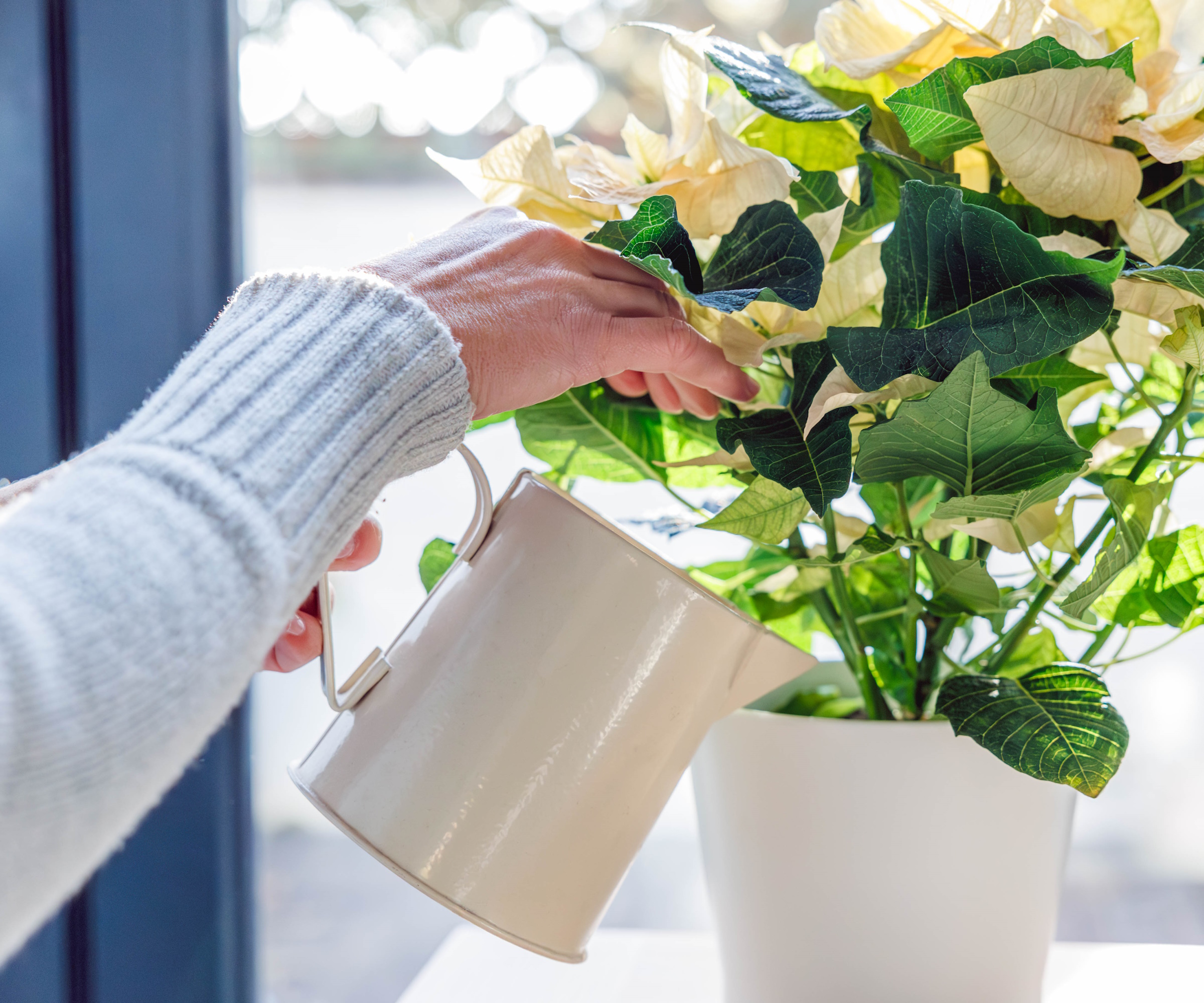Can poinsettias live outside in the winter? Keep these festive beauties thriving all season with these expert tips
Gardening experts share the ideal temperatures for poinsettias and essential care tips to keep them healthy outdoors throughout the winter


Poinsettias, with their iconic vibrant red leaves, have become holiday staples, embodying the festive spirit with their Christmas-themed appearance. Yet, despite looking perfectly suited for winter decor, these plants aren’t designed for cold weather.
Native to Central America, poinsettias thrive in warm, tropical climates, making them sensitive to the lower temperatures typical in many regions over winter. So, if you are wondering can poinsettias live outside in the winter, the answer largely depends on your region and the local winter climate.
In this guide, experts offer insights into the ideal temperatures and hardiness zones for poinsettias, along with essential poinsettia care tips to keep them healthy and vibrant – whether they’re outdoors in milder climates or indoors where winter temperatures drop.
Can poinsettias live outside in the winter?

Poinsettias are not cold hardy plants, and it's tricky to grow poinsettias outdoors drop below 50°F. For poinsettias to really thrive, they need temperatures between 65°F and 75°F. If your winter temperatures fall below this range, keeping poinsettias outdoors can be harmful and may lead to their demise.
'Poinsettias can only survive outdoors in USDA hardiness zones 9 to 11,' explains Mathew Wilson, horticulturist and CEO of Handy Gardeners. 'In warmer regions like parts of southern California, Texas, and Florida, they can be grown outside, but with care.
'However for colder regions, poinsettia plants should be brought inside until late spring, so that they do not get damaged due to frost or snow.’

Matthew Wilson, CEO of Handy Gardeners, leads the company with a passion for landscaping and environmental sustainability. Under his guidance, Handy Gardeners has become a trusted name in the industry, providing top-notch gardening and landscaping services.
How to protect poinsettias growing outdoors during mild winters

While they can survive outdoors in milder climates with temperatures as low as 50°F, long-term outdoor care in these areas can be challenging and requires specific winterization steps to help them thrive. If your poinsettia is dropping leaves, it could be due to common stressors such as insufficient light, drafts, sudden temperature drops, or improper watering watering.
Design expertise in your inbox – from inspiring decorating ideas and beautiful celebrity homes to practical gardening advice and shopping round-ups.
To enjoy the best poinsettias for Christmas, proper care is essential. Here's what the experts recommend:
1. Remain vigilant in monitoring outdoor temperatures
Even in warmer zones, it’s important to monitor overnight temperatures closely, since sudden drops can still pose a risk to your poinsettias. While these plants are more tolerant of mild winters, they are still sensitive to cold, especially when temperatures dip unexpectedly.
Matthew Wilson advises keeping a frost cover on hand for use during those unexpected cold snaps that can occur even in USDA zones 9 to 11. 'A frost cover (such as these handy bags from Amazon) helps shield the plant from chilling winds and frost, trapping heat around the plant and preventing damage to the delicate leaves and bracts,' explains Matthew.
Alternatively, if you have potted poinsettias, Wilson suggests relocating them indoors when temperatures drop below 50°F. 'Bringing the plants inside ensures they remain in a warm, controlled environment where they can continue to thrive.' Simply move them into a sunroom, greenhouse, or any other location that offers warmth and indirect light.
Keeping a close eye on the forecast and being prepared for temperature fluctuations, you can help protect your poinsettias from cold-related stress.

This wireless weather forecaster provides indoor and outdoor temperature and humidity readings, along with daily high and low measurements. It offers a hyperlocal, 12 hour weather forecast based on your current conditions, helping you stay prepared for changing weather patterns.
2. Ensure it receives adequate sunlight
Poinsettias require four to six hours of indirect sunlight daily, and ensuring they receive enough warmth from the sun is crucial for those planted outdoors in milder climates.
Positioning them in a location with morning sun and afternoon shade is ideal, as this provides the right balance of light and warmth. Overexposure to direct light can cause leaves to drop, so it's important to select a spot with filtered sunlight to protect the plant from stress.
3. Create a microclimate in your yard

One of the most effective ways to keep poinsettias healthy outdoors during winter is by creating a microclimate around them that shields them from wind and provides extra warmth. 'This can be achieved by placing them in sheltered areas that naturally retain heat,' says Lisa Wark, certified master gardener and Director of operations at Champion Distinctive Landscaping Design and Care.
Matthew Wilson suggests using insulated spaces with good light exposure, which help maintain delicate plants during colder months. Structures like walls, eaves, or fences can create a protective microclimate, offering additional warmth and shielding poinsettias from harsh winds.
Natural features which absorb and radiate warmth, like stones or rocks, are particularly useful in creating a warmer microclimate. Additionally, placing poinsettias near other plants that provide dappled shade and shelter will also provide warmth and wind protection.
If your outdoor poinsettias are planted in containers, be sure they are made from a material that retains heat and doesn't conduct the cold as quickly as others. Metal pots, for example, tend to get very cold and can quickly chill the roots, while ceramic containers offer slightly better insulation. However, wood, resin, and plastic pots are the best choices, as they take longer to react to temperature changes and retain heat better than metal or ceramic. We recommend this stylish Homerville wood pot planter from Wayfair.
Using mulch as a ground cover can also help insulate the soil, retaining warmth and moisture around the plant. This natural cedar mulch from Amazon has 4.5 stars from over 1,000 reviews. You should use fresh, high-quality potting mix – such as this PittMoss Plentiful potting mix from Walmart – as older mixes can become porous and more prone to freezing.
For even more protection, Lisa Wark suggests that greenhouse structures or cold frames can provide necessary warmth and humidity, helping poinsettias thrive in colder conditions by mimicking their tropical origins.

Lisa Wark is the Director of Marketing and Operations at Champion Distinctive Landscaping Design and Care. With over 15 years of experience in the landscaping industry, Lisa brings a unique blend of horticultural knowledge and marketing savvy to her role. Lisa is a certified Master Gardener and holds an MBA from Georgia State University. She regularly speaks at industry conferences, sharing insights on topics ranging from water-wise landscaping to leveraging social media for landscape businesses.
4. Water them appropriately

Another important thing to monitor is how often should you water a poinsettia to keep it healthy
'Simulating their native environment as much as possible by keeping their soil consistently moist but not waterlogged, and ensuring good drainage to prevent root rot,' explains Matthew Wilson. He recommends watering them only when the top inch of soil feels dry, with a principle of 'moisten, but skip soaking'.
For more efficient watering, consider installing an automated irrigation system to maintain the appropriate soil moisture levels without overwatering. In USDA hardiness zones 9-11, set the system to water about once a week during winter, ensuring the soil stays lightly moist but not saturated. This should be adjusted based on predicted rainfall – if rain is expected, pause the system to avoid excess moisture.
Use well-draining soil and a two inch thick layer at the base of the plant helps maintain consistent soil moisture levels.
5. Prune poinsettias in late winter
Pruning is another essential step in long-term care. Matthew Wilson recommends trimming poinsettias in late winter or just after blooming to encourage a bushy, compact shape and healthy bracts. This acts as a reset, supporting new growth and enhancing their resilience in outdoor settings.
For warmer climates, careful placement, temperature monitoring, and attentive care can help them thrive outdoors during the winter.
However, in colder regions, it’s best to treat poinsettias as indoor plants. If you still have time before temperatures drop significantly, consider potting your poinsettias and moving them indoors to safely enjoy their festive beauty through the season. Once winter has passed, you can move them back outside to enjoy warmer temperatures.
If bringing them indoors isn’t an option, consider propagating poinsettia as a backup, ensuring you have new plants ready for future seasons.

Lola Houlton is a news writer for Homes & Gardens. She has been writing content for Future PLC for the past six years, in particular Homes & Gardens, Real Homes and GardeningEtc. She writes on a broad range of subjects, including practical household advice, recipe articles, and product reviews, working closely with experts in their fields to cover everything from heating to home organization through to house plants. Lola is a graduate, who completed her degree in Psychology at the University of Sussex. She has also spent some time working at the BBC.